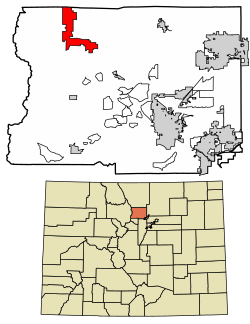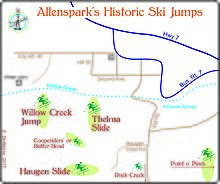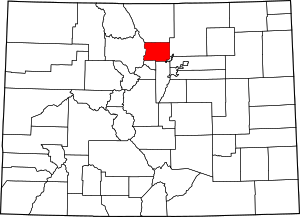Allenspark, Colorado
Allenspark is a census-designated place (CDP) in Boulder County, Colorado, United States. The population was 528 at the 2010 census.[3][4] The Allenspark Post Office has the ZIP code 80510.[2]
Allenspark, Colorado | |
|---|---|
 Location of Allenspark in Boulder County, Colorado. | |
| Coordinates: 40°12′9″N 105°30′48″W | |
| Country | |
| State | |
| County | Boulder County[1] |
| Government | |
| • Type | Unincorporated community |
| Area | |
| • Total | 11.8 sq mi (30.5 km2) |
| • Land | 11.7 sq mi (30.4 km2) |
| • Water | 0.04 sq mi (0.1 km2) |
| Elevation | 8,504 ft (2,592 m) |
| Population (2010) | |
| • Total | 528 |
| • Density | 45/sq mi (17.4/km2) |
| Time zone | UTC-7 (MST) |
| • Summer (DST) | UTC-6 (MDT) |
| ZIP code | 80510[2] |
| Area code(s) | 303 |
| Highways | |
| GNIS feature ID | 0178219 |
Geography
Allenspark is located in northwest Boulder County at 40°12′9″N 105°30′48″W (40.202416, -105.513341),[5] within Roosevelt National Forest in the Front Range of the Colorado Rockies. The western edge of the community is the boundary of Rocky Mountain National Park. State Highway 7 passes through the community, leading north 15 miles (24 km) to Estes Park and east 19 miles (31 km) to Lyons. The center of Allenspark is at an elevation of 8,500 feet (2,600 m) above sea level.
According to the United States Census Bureau, the CDP has a total area of 11.8 square miles (30.5 km2), of which 11.7 square miles (30.4 km2) is land and 0.04 square miles (0.1 km2), or 0.17%, is water.[6]
Demographics
| Historical population | |||
|---|---|---|---|
| Census | Pop. | %± | |
| U.S. Decennial Census[7] | |||
As of the census[4] of 2000, there were 496 people, 249 households, and 140 families residing in the CDP. The population density was 11.6 people per square mile (4.5/km2). There were 786 housing units at an average density of 18.4 per square mile (7.1/km2). The racial makeup of the CDP was 95.97% White, 0.20% African American, 0.60% Native American, 1.01% Asian, 0.60% from other races, and 1.61% from two or more races. Hispanic or Latino of any race were 1.61% of the population.
There were 249 households, out of which 13.3% had children under the age of 18 living with them, 53.4% were married couples living together, 1.2% had a female householder with no husband present, and 43.4% were non-families. 35.3% of all households were made up of individuals, and 8.8% had someone living alone who was 65 years of age or older. The average household size was 1.92 and the average family size was 2.45.
In the CDP, the population was spread out, with 11.5% under the age of 18, 4.0% from 18 to 24, 27.4% from 25 to 44, 42.5% from 45 to 64, and 14.5% who were 65 years of age or older. The median age was 49 years. For every 100 females, there were 105.8 males. For every 100 females age 18 and over, there were 105.1 males.
The median income for a household in the CDP was $42,596, and the median income for a family was $65,536. Males had a median income of $27,857 versus $35,208 for females. The per capita income for the CDP was $28,333. None of the families and 10.0% of the population were living below the poverty line, including no under eighteens and 10.7% of those over 64.
History
Allenspark is a park in the geographical sense—it is a high meadow surrounded by mountains. While it was first visited by Native Americans and later by trappers, Allen's Park—now spelled Allenspark—got its name from a miner who built the first cabin in the area.[8]
During the Colorado Gold Rush of 1859, Allenspark's namesake, Alonzo Nelson Allen, left his family in Columbus, Wisconsin, to seek his fortune in the Kansas/Nebraska Territories that became Colorado. He settled on the St. Vrain River, south of the current city of Longmont, Colorado.
Allen prospected and ran cattle in Allenspark and built a cabin there in 1864. The cabin burned down in 1894, the year Allen died.[9]
The village of Allenspark is situated on part of the original George Mack homestead, site of Crystal Springs, an excellent water source. After Mack's homestead patent was granted on January 7, 1895,[10] Mack sold some of the land to the Allens Park Land and Townsite Co. on May 9, 1896. The land company filed a plat for the village on May 23, 1896,[11] and began selling small building lots.
In Weaving Mountain Memories, Lorna Knowlton writes, "George Pheifer, a prominent early settler who came into Allenspark over the Stone Mountain Road from Lyons in 1896, said Allen never homesteaded his land but merely squatted on it in 1864. Pheifer said, 'All Alonzo Allen ever did for Allenspark was to give it a name.'"[9]
In the late 1890s, most residents of the Allenspark area were farmers or ranchers, but by the early 1900s there was a resurgence in gold fever. The Clara Belle Mining and Reduction Co. attracted investors from as far away as Omaha, Nebraska, for what turned out to be a folly. Meanwhile, tourism was booming, and farmers and miners alike found a better income catering to tourists during the summer months. The first post office application was filed on May 29, 1896, by C.K. Hirshfeld.[12]
The village of Allenspark began to grow when summer people bought land and built cabins from around 1900 to 1920. Many people came up the South St. Vrain canyon from Longmont, and a number came from as far away as Kansas and Oklahoma in that initial burst. The greater Allenspark area extends beyond the village to include the small communities of Ferncliff, Longs Peak, Meeker Park, Peaceful Valley, Raymond, and Riverside, and is defined by the boundaries of the Allenspark Fire Protection District.
Allenspark remained primarily a summer destination until improved roads and modern technology made mountain living easier than it used to be. Now, many people live year-round in the Allenspark area. In 2000, 500 residences were listed in the phone book.[13] The 2010 census counted a total of 892 housing units, 267 of which were occupied on Census Day (April 1) and 577 of which were seasonally occupied.[14]
Many businesses are still only open during the summer. Businesses include restaurants, lodges, summer camps, coffee shop, and gift shops. There are no filling stations, and cell-phone coverage is nearly non-existent.
Skiing was popular in the Allenspark area in the 1920s and 1930s, when international ski jumping competitions were held. Jumps and ski courses included the Willow Creek Slide, Thelma Slide, Butter Bowl, Haugen Slide, and Point-O-Pines. The Rock Creek Ski area was developed after World War II and operated until 1952. Cross-country skiing is still popular, especially on Rock Creek and in Wild Basin.[15]

See also
- Outline of Colorado
- State of Colorado
- Colorado cities and towns
- Colorado census designated places
- Colorado counties
- Colorado metropolitan areas
- Front Range Urban Corridor
- North Central Colorado Urban Area
- Denver-Aurora-Boulder, CO Combined Statistical Area
- Boulder, CO Metropolitan Statistical Area
- Colorado cities and towns
- United States Forest Service
- United States National Park Service
References
- "US Board on Geographic Names". United States Geological Survey. 2007-10-25. Retrieved 2008-01-31.
- "ZIP Code Lookup". United States Postal Service. December 14, 2006. Archived from the original (JavaScript/HTML) on 14 December 2006. Retrieved December 14, 2006.
- Colorado Trend Report 2: State and Complete Places (Sub-state 2010 Census Data). Archived 2012-07-11 at Archive.today Missouri Census Data Center. Accessed 2011-02-25.
- "U.S. Census website". United States Census Bureau. Retrieved 2008-01-31.
- "US Gazetteer files: 2010, 2000, and 1990". United States Census Bureau. 2011-02-12. Retrieved 2011-04-23.
- "Geographic Identifiers: 2010 Demographic Profile Data (G001): Allenspark CDP, Colorado". U.S. Census Bureau, American Factfinder. Archived from the original on February 12, 2020. Retrieved September 27, 2013.
- "Census of Population and Housing". Census.gov. Retrieved June 4, 2016.
- Knowlton, Lorna, and DeWeese, Edie (2011). Weaving Mountain Memories: Recollections of the Allenspark Area, p. 3. Allenspark: Allenspark Wind.
- Knowlton, p. 4.
- Homestead Patent COCOAA 004669; General Land Office Records, U.S. Dept. of the Interior, Bureau of Land Management; Retrieved 2013-07-01.
- Boulder County Clerk and Recorder; Retrieved 2013-07-01.
- Knowlton, p. 97.
- "Community Wildfire Protection Plan," Allenspark, Colorado (2009). Retrieved 2013-07-25.
- "Profile of General Population and Housing Characteristics: 2010 Demographic Profile Data (DP-1): Allenspark CDP, Colorado". U.S. Census Bureau, American Factfinder. Archived from the original on February 12, 2020. Retrieved September 27, 2013.
- Knowlton, p. 143.
External links
| Wikimedia Commons has media related to Allenspark, Colorado. |
- Allenspark Community Information Portal
- The Allenspark Wind, local newspaper
- Allenspark Visitor, online guide
- Allenspark Old Gallery, not-for-profit community center, music venue, art center
